
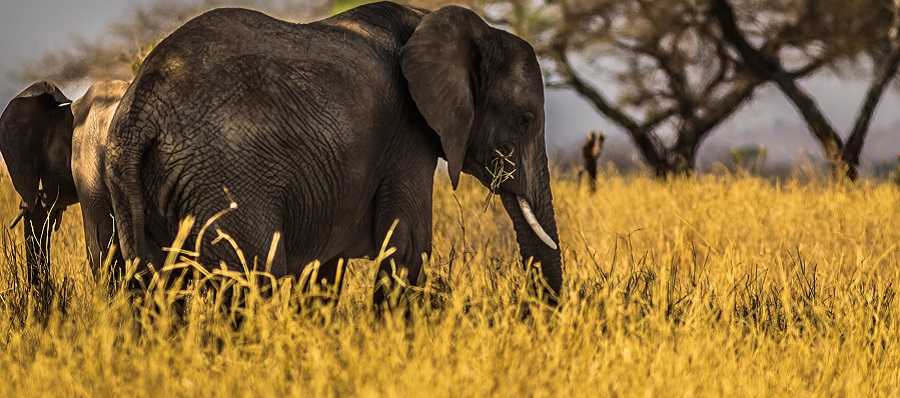
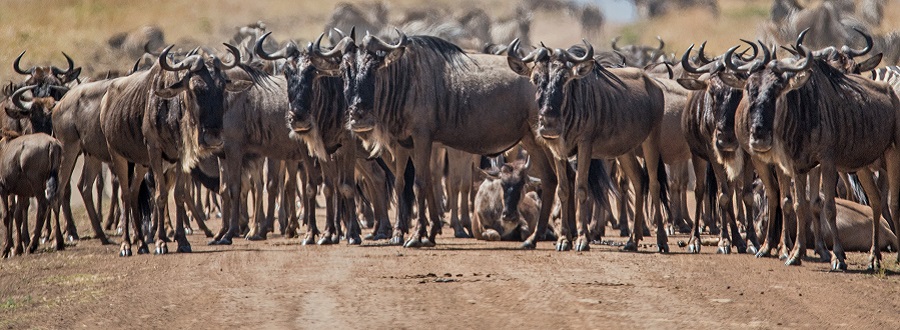
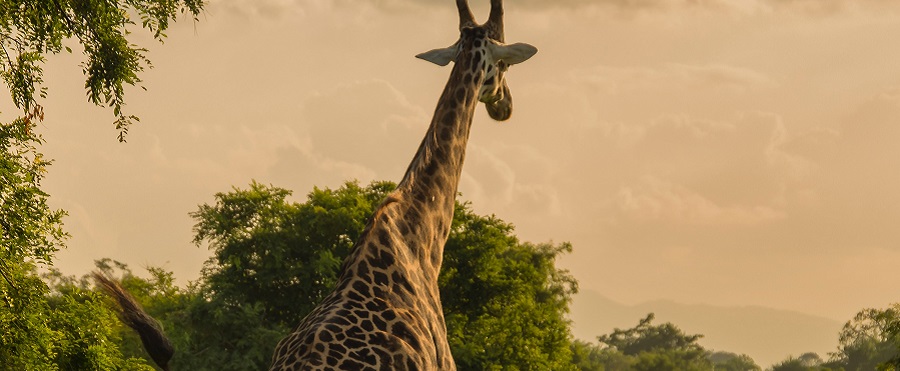

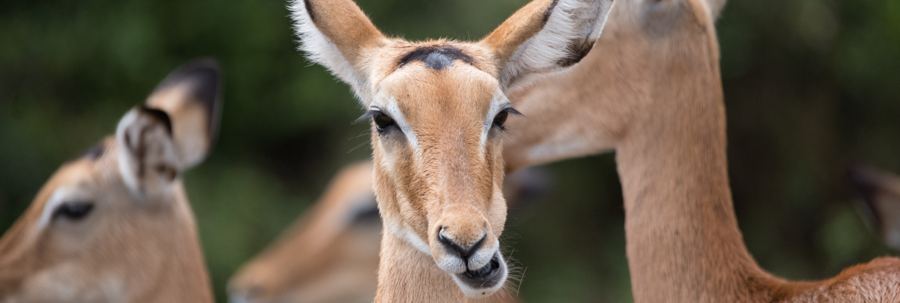
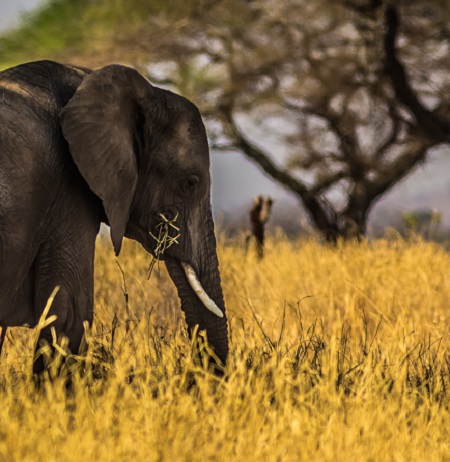
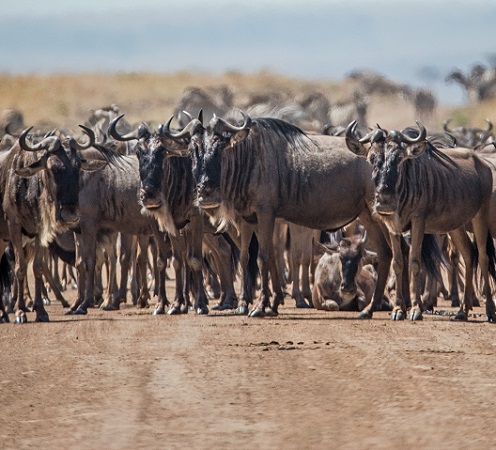
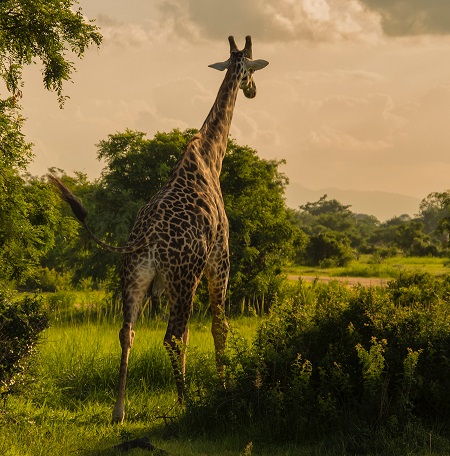
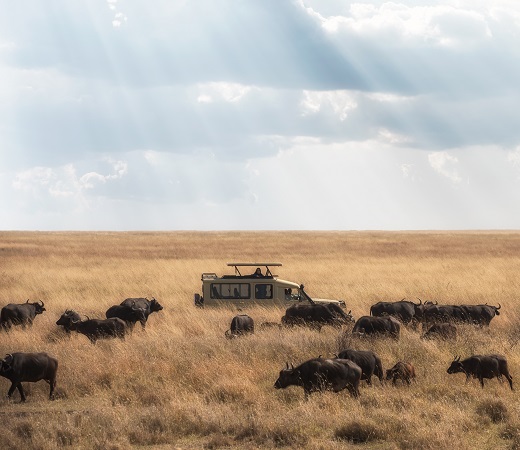
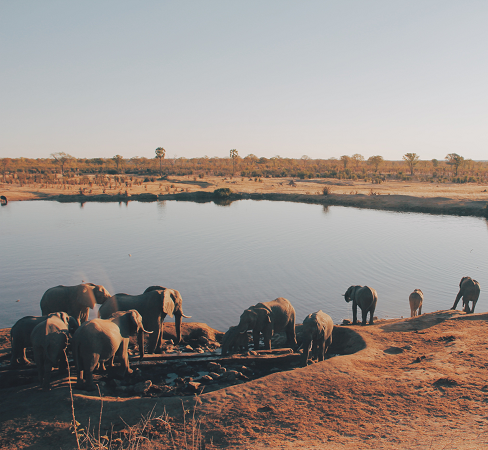
Optie één
Wir bieten unseren Kunden einen angemessenen Preis und wir haben ausgezeichnete Bewertungen ....
Wir bieten einen guten Preis
Am Morgen verlassen wir Arusha und fahren in den Tarangire-Nationalpark, wo Sie die kolossalen Termitenhügel und die alten Affenbrotbäume bestaunen können. Die malerische Landschaft und die vielfältige Vogelwelt tragen dazu bei, das ruhige Ambiente des Tarangire-Nationalparks zu schaffen. Die große Elefantenpopulation ist ein äußerst bemerkenswerter Anblick. Afrikanische Elefanten sind das größte Landsäugetier und erwachsene Männchen können bis zu sieben Tonnen wiegen. Tarangires vielfältige Tierwelt umfasst Löwen, Giraffen, Warzenschweine, Strauße, Impalas, Geparden, Mungos, Büffel und Paviane. Wenn Ihre Pirschfahrt zu Ende ist, bringen wir Sie zum Lake Manyara, wo Sie zu Abend essen und über Nacht.
Ein appetitliches Frühstück bringt Sie nach Ngorongoro in den Serengeti-Nationalpark. Wir nehmen die malerische Route zur Serengeti, die es uns ermöglicht, in der Nähe des Ngorongoro-Kraters zu reisen. Es besteht die Möglichkeit, ein Spiel zu entdecken. Die endlose goldene Savanne mit Farbflecken, die durch die Vegetation und die Tierwelt erzeugt werden, macht es leicht zu verstehen, warum die Serengeti eines der sieben Naturwunder Afrikas ist. Wir halten an, damit Sie Ihr Picknick auf einem Kopje (einem kleinen Hügel in einer im Allgemeinen flachen Gegend) genießen können. Wir werden weiter in die Serengeti fahren, um eine gemütliche Pirschfahrt zu machen. Sie übernachten in der Serengeti
Wir beginnen unseren Tag mit einer Pirschfahrt am frühen Morgen in der zentralen Serengeti. Die Savanne ist eine aktive Landschaft und die Luft ist mit den Melodien überflutet, die die Vögel erzeugen, wenn das regenerierte Sonnenlicht die gesamte Landschaft beleuchtet. Ihr Führer wird die Drucke vor Ort studieren, um Raubtiere zu verfolgen. Wir werden zum Ngorongoro Krater reisen. Sie erhalten Abendessen und Übernachtung
Nach einem Frühstück am frühen Morgen beeilen wir uns zum Ngorongoro-Krater, da dies die beste Zeit ist, um Tiere zu beobachten. An diesem Tag genießen wir eine Pirschfahrt um den Krater und machen ein Picknick an einem kleinen See im Park. Der See ist die Heimat vieler Flusspferde und Zugvögel, so dass die Gäste den Besuch sicher genießen werden! Aufgrund der im Krater geschaffenen Tieroase besteht eine hohe Wahrscheinlichkeit, dass jedes Mitglied von „The Big 5“ entdeckt wird. Die Gruppe besteht aus einigen der stärksten Tiere Afrikas - dem wilden Löwen, dem Riesenelefanten, dem heimlichen Leoparden, dem stürmenden Nashorn und dem mächtigen Wasserbüffel. Der Ngorongoro-Krater ist wirklich ein erstaunlicher Ort. Wussten Sie, dass es vor über zwei Millionen Jahren entstanden ist? Ein großer Vulkan brach aus und stürzte den Vulkan ein, hinterließ jedoch einen vollkommen ununterbrochenen Krater, der als Caldera bekannt ist. In dem erstaunlichen Krater können Sie das verspielte Zebra, das schwerfällige Nilpferd, das schnelle Gnu und die gackernden Hyänen beobachten.
ABOUT OUR SAFARI VEHICLES
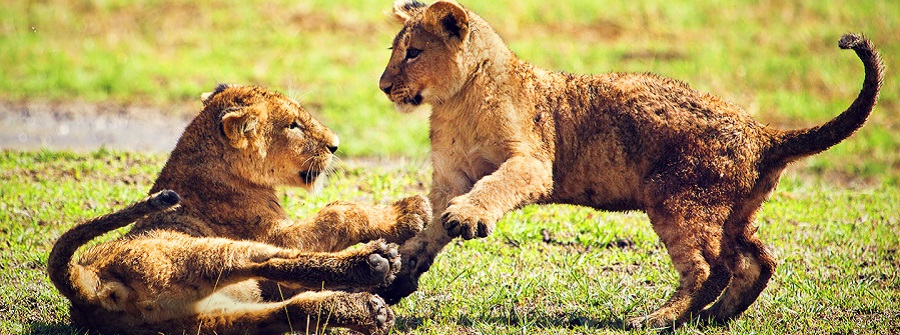
You will be staying at camping-sites and lodges!
Optie twee
Wat mag je verwachten van deze safari? Deze Ndutu-migratiesafari tijdens het kalven-tour is speciaal ontworpen om je te concentreren op en om je kans te vergroten om de grote migratie van de Serengeti-gnoes te zien. De zuidelijke Serengeti- en Ndutu-gebieden in Tanzania zijn de beste locaties voor de maanden januari, februari en maart om getuige te zijn van duizenden gnoes verspreid over de vlaktes die grazen op de rijke korte grasvlaktes. Roofdieractie is op zijn hoogtepunt met geweldige waarnemingen van cheeta's, leeuwen, hyena's en luipaarden en een zeer goede kans om spectaculaire, met adrenaline gevulde kills te zien.
Na een ontbijt worden de toerist(en) opgehaald bij het hotel in Arusha en vervolgens naar de luchthaven van Arusha gebracht voor een korte vlucht (50 minuten) / auto (4x4 jeep open dak) naar Serengeti North Ndutu Area. Bij aankomst ontmoeten toerist(en) een autobestuurder-gids voor een gamedrive van een hele dag in Ndutu om de magnifieke migratie te bekijken. 'S Avonds rijden we naar het kamp voor diner en overnachting. Lake Ndutu-gebied, gelegen in het beschermde natuurgebied Ngorongoro, onderdeel van het zuidelijke Serengeti-ecosysteem. Lake Ndutu is alkalisch, net als de meeste andere Rift-meren, maar het water is nog steeds drinkbaar en wordt gebruikt door een breed scala aan lokale dieren in het wild. Het grootste deel van de migratie van gnoes is normaal gesproken te vinden op de kortgrasvlaktes van december tot april. Het gebied is meestal dichtbevolkt met olifanten, spectaculaire vogels en wild. Maaltijden: B, L, D Accommodatie: Kamp of Lodge.
Op dag twee hebben toerist(en) een gamedrive in de vroege ochtend in Ndutu Area en in de middag terug naar het kamp voor de lunch. Je zult ook genieten van een avondspel en dan terug naar het kamp voor diner en overnachting. Er wordt uitgebreide uitleg gegeven over dit geweldige en sfeervolle wereldevenement waar Tanzania trots op is. En 's avonds als de zon ondergaat, het oudste en meest populaire nationale park van Tanzania, ook een werelderfgoed en onlangs uitgeroepen tot een 7e wereldwonder, is de Serengeti beroemd om zijn jaarlijkse migratie. Maaltijden: B, L, D Accommodatie: Kamp of Lodge
Het Serengeti National Park staat bekend om zijn gezonde voorraad van andere in het wild levende dieren, met name de "big five", genoemd naar de vijf meest gewaardeerde trofeeën die door jagers zijn genomen: Leeuw: de Serengeti wordt verondersteld de grootste populatie leeuwen in Afrika te bevatten vanwege voor een deel aan de overvloed aan prooisoorten. In dit ecosysteem leven meer dan 3.000 leeuwen. Afrikaanse luipaard: deze teruggetrokken roofdieren worden vaak in de buurt gezien. Maaltijden: B, L, D Accommodatie: Kamp of Lodge.
Toeristen zullen genieten van een gamedrive in de ochtend en daarna terug naar het kamp voor het ontbijt. Daarna rijden ze door een chauffeur terug naar Arusha. Je wordt op eigen afspraak naar je hotel gebracht.

Transport (4x4 Land Cruiser) met open dak
Parkkosten
ontbijt; lunches; avondeten
18% btw op tourkosten en diensten die bijna 55% van de totale in rekening gebrachte kosten kosten.
Budget/ Medium/ Luxe Accommodaties
Professionele Engelssprekende safarigids & chef-kok
1,5 fles water per dag; thee en koffie bij de maaltijden
You will be staying at camping-sites and lodges!
Zowel Nationale als Internationale vluchten
Medische verzekering
Visumkosten die $ 50 zijn, behalve voor Canadese en Amerikaanse paspoorthouders, die $ 100 zijn
Tip Safari gids & kok
Wasservice
Artikelen van persoonlijke aard
Alcoholische dranken
Extra activiteiten (Ballonvlucht $600 per persoon & Masai Village $25 per persoon)
Optie drie
Tijdens deze beroemde safari verken je twee van de 7 natuurwonderen van Afrika. Bekijk de adembenemende migratie van wildebeesten bij Serengeti en spot een van de zeldzame neushoorns in de Ngorongoro-krater. Op deze safari beleef je een Afrikaans avontuur dat je stoutste dromen overtreft.
We verlaten Arusha bij zonsopgang en reizen naar Serengeti National Park. We reizen naar Serengeti over een weg in de buurt van de rand van de Ngorongoro-krater, waar we onderweg een glimp van dieren kunnen opvangen. De gouden savanne en eindeloze vlaktes, vol met zebra's, gnoes en giraffen, zullen het voor u een stuk gemakkelijker maken om te begrijpen waarom de Serengeti een van de zeven natuurwonderen van Afrika is. Gedurende deze dag zullen we genieten van een picknicklunch op het Naabai kopje (een kleine, rotsachtige heuvel in een over het algemeen vlak gebied), waar je de kans krijgt om de beroemde rozekophagedissen van de Serengeti te zien. Na de lunch gaan we verder de vlaktes in voor een ontspannen gamedrive. Je overnacht in de Serengeti en valt in slaap met de speelse roep van de zebra's en hyena's. Zoals bij gegarandeerd bij elke tour, Hoofdaccommodatie Accommodaties: Klanten selectie Openbare camping/ Getinte camping/ Lodges Maaltijden: Water wordt gecombineerd in alle maaltijden (andere drankjes zijn niet inbegrepen)
We beginnen de dag in het hart van de Serengeti. De dieren die in de Serengeti worden gevonden, zijn extreem gevarieerd, dus bezoekers zullen waarschijnlijk genieten van het uitzicht op leeuwen, luipaarden, olifanten, cheeta's, waterbuffels, zebra's en gnoes. Daarnaast zijn elanden, hyena's, gazellen, krokodillen, giraffen, zebra's, apen, bavianen, nijlpaarden, neushoorns en antilopen allemaal te vinden in het park. Maak je geen zorgen over de tijd van het jaar van je safari, want er zijn het hele jaar door dieren in de Serengeti! Na de gamedrive wordt er een heerlijk diner geserveerd. Hoofdaccommodatie Accommodaties: Klanten selectie Openbare camping/ Getinte camping/ Lodges Maaltijden: Water wordt gecombineerd in alle maaltijden (andere drankjes zijn niet inbegrepen)
In this day marks the last day of game drive in Serengeti before we make our way to Ngorongoro Crater. After an exciting game drive full of animal sightings and a picnic lunch, we will drive to the Crater. This night we will stay there, overlooking the unbroken caldera of Ngorongoro Crater. The views of the sunset over the savannah are definetly breathtaking. After a long day of adventuring, guests will enjoy a tasty dinner prepared by our friendly cook.
Main Accommodation
Accommodations: Clients selection Public campsite/ Tinted campsite/ Lodges Meals: Water is combined in all meals (Other drinks is not inbegrepen)
Na een vroeg ontbijt in de ochtend, haasten we ons naar de Ngorongoro-krater, omdat dit de beste tijd is om dieren te spotten. Binnen deze dag zullen we genieten van een gamedrive rond de krater en stoppen voor een picknicklunch bij een klein meer in het park. Het meer is de thuisbasis van vele nijlpaarden en trekvogels, dus gasten zullen zeker genieten van het bezoek! Vanwege de dierlijke "oase" die in de krater is gecreëerd, is er een grote kans om elk lid van 'The Big 5' te spotten. De groep omvat enkele van de sterkste dieren in Afrika - de woeste leeuw, de gigantische olifant, de sluipende luipaard, de aanvallende neushoorn en de machtige waterbuffel. Ngorongoro Crater is echt een geweldige plek. Wist je dat het meer dan twee miljoen jaar geleden werd gevormd? Een grote vulkaan barstte uit, de vulkaan stortte in, maar liet een perfect ongebroken krater achter, bekend als een caldera. Binnen de verbazingwekkende krater kun je de speelse zebra's, logge nijlpaarden, snelle gnoes en kakelende hyena's verwachten. Daarnaast zijn er zwermen sierlijke flamingo's langs het Sodameer, terwijl hongerige haviken en gieren door de lucht cirkelen op zoek naar hun volgende maaltijd van verwijderd karkas. Mooie ooievaars, ibis en kraanvogels zijn populaire watervogels in de krater, een bezienswaardigheid die je niet mag missen. Na een heerlijke middag dieren spotten, beginnen we eindelijk aan onze reis terug naar Arusha.
Het is eigendom van Africa Natural Tours & Safaris Company Limited
Wilt u GEEN kilometerstand of brandstoflimieten
Hoge onderhoudsnormen, we hebben een eigen onderhoudswerkplaats.
Onze beide Safari Cars zijn Nieuw
Al onze auto's zijn 4x4 met uitzetdaken
Al onze auto's hebben koeler
Al onze safariauto's hebben oplaadpoorten voor camera's.
De meeste van onze auto's zijn voorzien van airconditioning
Wij zorgen voor Water tijdens Safari.

Vervoer (4x4 Land Cruiser) met open dak
Campings/Lodge
parkkosten
Tent
matras
Professionele Engelssprekende safarigids & chef-kok
ontbijt; lunches; avondeten
1,5 fles water per dag; thee en koffie bij de maaltijden
18% btw op tourkosten en diensten die bijna 55% van de totale kosten kosten
You will be staying at camping-sites and lodges!
Vluchten (internationaal en binnenlands)
Reisverzekering
Visa kost $ 50, behalve voor Canadese en Amerikaanse paspoorthouders, die $ 100 zijn
Persoonlijke spullen
Tips voor safarigids & chef
Soda en alcoholische dranken
Extra activiteiten (Ballonvlucht $600 per persoon & Masai Village $25 per persoon)
Optie vier
Geniet van de eerste stappen van een van de meest slopende en boeiende reizen van de natuur terwijl je getuige bent van het afkalfseizoen. Het afkalfseizoen markeert het begin van deze beweging waarbij honderdduizenden dieren de moeilijke reis van de zuidelijke Serengeti naar het verre Maasai Mara maken. Tijdens je vierdaagse safari in het afkalfseizoen kun je naar het landelijke park Lake Manyara gaan, een tocht maken naar de zuidelijke Serengeti om de afkalflocatie van Ndutu te bekijken, en je excursie afsluiten met een bezoek aan de mooie omgeving van Ngorongoro Conservation. Als je timing goed is, zou je misschien zelfs de eerste stappen van de noordwaartse beweging van deze grote kudde te zien krijgen.
Je verlaat Arusha voor een later ontbijt naar Lake Manyara National Park. De reis duurt ongeveer twee uur, maar we passeren onderweg het marktstadje Mto wa Mbu. Deze markt voor landbouwproducten en verse producten is een smeltkroes van lokale culturen en een paradijs voor souvenirjagers. Na een korte stop op de markt op het platteland, betreed je Lake Manyara, Nationaal Park. Het park is echt een speeltuin voor fotografen en biedt enkele van de beste gameviews ter wereld. Je kunt veel van Afrika's meest bekende dieren verwachten, met als bijzondere traktatie de in bomen klimmende leeuwen. Deze trotse roofdieren loungen in acaciabomen en smeken bijna om gefotografeerd te worden. Vogelaars zullen ontdekken dat Lake Manyara een absoluut genot is, met een breed scala aan vogels die in het park te zien zijn. Zelfs de beginner kan versteld staan van grote zwermen flamingo's, rondcirkelende roofvogels en de felgekleurde lila-breasted roller. Daarna trekt u zich terug in de door u gekozen accommodatie voor het diner en een goede nachtrust. In een kamp of lodge
We zullen vroeg ontbijten, want we hebben vooraf een grote dag van verkenning en avontuur gekregen mensen! We beginnen de dag met de landschappelijke kracht dichter bij de Ndutu-locatie van de Serengeti/Ngorongoro Conservation-omgeving. onderweg huppelen we door de met mist gehulde regenwouden van de Ngorongoro Conservation-omgeving, waar je misschien het geluk hebt om een glimp op te vangen van Kaapse buffels, bavianen of zelfs olifanten en luipaarden in het dichte kreupelhout. Het is bijna anderhalve rit naar Ndutu, maar je kunt ervoor kiezen om het avontuur te verbreken met een of elk van de niet-verplichte activiteiten: Oldupai Gorge Museum: het Oldupai Gorge Museum, ook wel bekend als de bakermat van de mensheid, herdenkt een aantal van de oudste bewijzen van menselijke bewoning ooit. hier kun je een aantal van de vroegste fossiele bewijzen zien in de internationale menselijke bewoning, het Oldupai Gorge Museum bezoeken om meer te leren over het menselijke avontuur en genieten van het prachtige uitzicht op deze grimmige kloof Maasai boma ga naar: Breng een bezoek aan een van de beroemde Maasai boma's, waar je de kans krijgt om getuige te zijn van (en deel te nemen aan) conventionele Maasai dans, excursies en het echte Maasai dorp, en zelfs een klein souvenir te kopen in de nabijgelegen marktplaats. Voor beide bovengenoemde sporten geldt een toeslag. Praat met uw safari-expert over het toevoegen van hen aan uw reisschema. Na een heerlijke lunch op de picknickplaats, is het tijd om de Ndutu-locatie te verkennen. Wees getuige van het iconische savannelandschap van Afrika en sta versteld met de hulp van het enorme aantal dieren dat door die grasvlakten dwaalt. U kunt genieten van het kijken naar de gigantische kuddes gnoes die over de locatie trekken. Diner en op één dag in het hart van het gebied in de pas met dezelfde oude en het soort accommodatie gevraagd van onze opties.
Je staat voor zonsopgang op zodat we overal op de locatie kunnen genieten van een ochtendrecreatie. Zie de vuurplaats bij zonsondergang naar de savanne als carnivoren, waaronder cheeta's en leeuwen in beweging, terwijl het toch koel genoeg is om te jagen. Na je zonsopgangsrecreatie, keer je terug naar je motel voor het ontbijt voordat je een picknicklunch neemt en op weg gaat om Ndutu te verkennen. Je zult een middaglange recreatiedruk ervaren door de locatie, langs de oevers van elk Ndutu- en Masek-meer, evenals het omringende land waar tientallen jonge gnoes hun eerste stappen zetten. Na je daglange verkenning van Ndutu, overnacht je in Camp / motel.
Na het ontbijt vertrek je naar Ngorongoro Crater, met de hulp van enkelen beschouwd als de 8e verrassing van de sector. Terwijl je je eerste glimp opvangt van deze substantiële, groene caldera vanuit het panoramische perspectief, zul je snel begrijpen waarom het zo'n verheven reputatie heeft verdiend. De Ngorongoro Conservation-regio is de thuisbasis van meer dan 120 soorten zoogdieren en de legendarische massieve 5 en is een van de meest gewilde safaribestemmingen ter wereld. het is een bijzonder goede locatie om de met uitsterven bedreigde zwarte neushoorn een ongehuwde maaltijd te zien spelen op de grasvlaktes, naast een gebied om enorme aantallen nijlpaarden te zien die deelnemen aan het koele water. Vanuit het comfort van uw open voertuig kunt u wellicht een aantal van de meest herkenbare gezichten van Afrika bekijken en fotograferen. De krater is gedomesticeerd voor een grote hoeveelheid roofdieren, samen met leeuwen, luipaarden, cheeta's, jakhalzen en hyena's, evenals een enorme populatie gnoes, zebra's, antilopen, Kaapse buffels en meer. Het is echt een van de beste safaribestemmingen van Afrika. Na de spanning en opwinding van de dag, geniet je van een picknicklunch bij het beroemde nijlpaardzwembad van het park voordat je in één dag terugkeert naar Arusha.
Het is eigendom van Africa Natural Tours & Safaris Company Limited
Wilt u GEEN kilometerstand of brandstoflimieten
Hoge onderhoudsnormen, we hebben een eigen onderhoudswerkplaats.
Onze beide Safari Cars zijn Nieuw
Al onze auto's zijn 4x4 met uitzetdaken
Al onze auto's hebben koeler
Al onze safariauto's hebben oplaadpoorten voor camera's.
De meeste van onze auto's zijn voorzien van airconditioning
Wij zorgen voor Water tijdens Safari.

Vervoer (4x4 Land Cruiser) met open dak
Parkkosten
18% btw op tourkosten en diensten die bijna 55% van de totale kosten kosten.
Budget/ Medium/ Luxe Accommodaties
Professionele Engelssprekende safarigids & chef
ontbijt; lunches; avondeten
1,5 fles water per dag; thee en koffie bij de maaltijden
You will be staying at camping-sites and lodges!
Zowel Nationale als Internationale vluchten
Ziektekostenverzekering
Visumkosten die $ 50 zijn, behalve voor Canadese en Amerikaanse paspoorthouders, die $ 100 zijn
Tip Safari gids & kok
Persoonlijke spullen
Wasservice
Alcoholische dranken
Extra activiteiten (Ballonvlucht $600 per persoon & Masai Village $25 per persoon)
Tanzania is a vibrant and beautiful country with exceptional parks and reserves. It’s blessed with the winning combination of unparalleled game viewing and dazzling tropical beaches. Because Tanzania is so vast (almost 1.5 times the size of Texas), it helps to divide the country’s major holiday destinations into four areas:
1. Northern Safari Circuit – the most popular Tanzania safari route comprising the Serengeti, Ngorongoro, Lake Manyara, Tarangire and Kilimanjaro.
2. Tanzania Coast and Islands – the country’s beaches, especially those on islands like Zanzibar, are breath-taking and very accessible.
3. Southern Tanzania – includes the wonderfully wild and underrated Nyerere and Ruaha, Tanzania’s best-kept safari secrets.
4. Western Tanzania – head to the far-flung corners of Katavi and Mahale for the ultimate off-the-beaten-path Tanzania safari experiences.
Serengeti National Park: A Safari Superstar
Synonymous with safari, the Serengeti is where to go in Tanzania for game viewing at its most dramatic. Hosting the lion’s share of the Wildebeest Migration (about January to September), the Serengeti's sheer size, accessibility, top-quality lodges and camps, and year-round abundance of wildlife make it one of the best safari destinations in Africa.
Serengeti Safaris
From the Wildebeest Migration to Year-round Game Viewing
Home to one of the world’s greatest concentrations of wildlife and the majority of the Great Wildebeest Migration, Serengeti National Park is Tanzania’s flagship conservation area and a must-do for first-time and returning safari goers alike.
Translated from the Maa language as ‘the land that moves on forever’, the Serengeti’s vast rolling grasslands and golden savannah give travellers a soul-stirring sense of space. Although it is most famous for supporting millions of wildebeest, there are also sizable populations of zebra, buffalo, elephant and giraffe, and myriad gazelle and antelope species. And where there are plains game aplenty, predators like lion, leopard, cheetah, hyena and wild dog are sure to follow.
From the Wildebeest Migration to incredible year-round game viewing, here are some of our best reasons to go on a safari in the Serengeti:
1. Witness the Annual Wildebeest Migration
The Great Wildebeest Migration is one of the last mass terrestrial animal movements left on the planet, and the main reason why so many wildlife enthusiasts visit the Serengeti – especially at mid-year. Watching herds of biblical proportions move across the plains will stir your soul unlike anything else. It truly is one of Mother Nature’s greatest spectacles! The herds undergo challenges and hardships as they move from region to region, constantly under attack from predators like Africa's big cats and the notoriously huge crocodiles that lie in wait at river crossing points.
• Mobile camps move regularly to stay as close to the herds as possible.
• Some accommodations offer easy access to river crossing points.
• Calving season (February to March) delivers plenty of bittersweet predator action.
• The Great Wildebeest Migration is one of the last mass terrestrial wildlife movements left on the planet. It's the chief reason why so many travellers venture to Kenya and Tanzania for a Migration safari, especially around mid-year.
• The Migration is one of Nature's greatest paradoxes: timing is absolutely vital, but there is no way to predict the timing of the animals' movements. We know that the wildebeest (and a smattering of zebra and antelope) will cross the Mara River – but nobody knows exactly when. We also know that rain will trigger the wildebeest to move onto fresh grazing – but nobody knows exactly when the rain will fall.
• Fortunately, we've been planning Wildebeest Migration safaris since 1998. We've helped thousands of travellers to be in the best possible place at the best possible time for the best possible price. If you're looking for expert planning advice, look no further. We've compiled all our specialist tips in this handy beginner's guide to a Wildebeest Migration safari...
How the Wildebeest Migration Works
Common Misconceptions About the Wildebeest Migration:
1. The River Crossings Can Be Predicted
Not even the wildebeest know when they're going to cross! Some arrive at the water and swim over immediately; some arrive and spend days hanging around grazing; some arrive and turn back to where they came from. We wish we could predict the crossings, but no-one can. This is why it is best to have as much time on safari as possible if you hope to see a river crossing
.
2. The Migration Only Happens Between July & October
Most people think that the Wildebeest Migration only takes place between July and October, but it's actually a year-round phenomenon – with various but equally exciting events that occur at different times of the year. The river crossings usually coincide with safari's high season (July to October), hence the perception that this is the only time of the year that the wildebeest are on the move or can be seen.
What Happens When: A Month-by-Month Breakdown
With climate change, the long and short rainy seasons in Tanzania and Kenya are no longer as regular or predictable as they once were. The rains can be late or early, which will throw the whole wildebeest calendar out of synch. This is, once again, why it’s important to plan for as much time on safari as possible. You cannot fly in for two nights, see a river crossing and fly out again – nature simply doesn’t work that way.
This is a very general guideline for where the herds are during the year – bearing in mind that the entire Migration is triggered by rain, which can be early, late or on time:
January
The herds are in Tanzania's Serengeti National Park, moving south from the north-east region and into the area near Lake Ndutu. The Serengeti is not fenced, so the herds are free to move where they can find grazing. Remember that although up to two million wildebeest, zebra and antelope form the Migration, they are not all in a single herd. The animals break up into mega-herds of thousands or hundreds of individuals at time.
February to March
It is calving season (over 8 000 wildebeest babies are born each day!) so prepare yourself for lots of wobbly calves... and lots of heartbreak as fearsome predators swoop in. The Serengeti's big cats take the lion’s share, but hit-and-run jackals, packs of wild dog, and hyena clans add to the spectacle. It’s a bittersweet ballad; the circle of life played out as a live action drama.
If the short rainy season (Nov–Dec) produced good grazing, the herds feed frenziedly and remain in the Serengeti's southern plains until they slowly start moving west in March.
April
It's the start of the long rains (Apr–May) and the herds generally move in a north-westerly direction towards the Moru and Simba Kopjes. The action-packed rutting (breeding) season is in full swing, featuring testosterone-fuelled jousts between males competing for the right to mate with receptive females.
May
Wagons roll! The massed herds are on the go, huge columns of up to 40 kilometres (25 miles) in length can sometimes be seen as the wildebeest funnel up into the central Serengeti. Everyone's moving a little quicker now that the calves are stronger.
June
The wildebeest are usually in the central Serengeti and getting ready for the toughest part of their odyssey. The herds may have split up, with some already crossing the Grumeti River.
July
The herds have reached the Grumeti region and northern parts of the Serengeti and are peering closely at the treacherous waters of the Mara River they have to cross into Kenya. Why? Huge Nile crocodiles, that's why!
As mentioned, it is impossible to accurately predict river crossings – they depend entirely on the rains and the often unpredictable wildebeest themselves. It's vital to book your Wildebeest Migration safari up to a year in advance to get a lodge on or as close to the river as possible – this cuts down on travel time to lookout points. The wildebeest do have historical crossing areas and you may spend days staked out in the hope of seeing the action. We recommend choosing a mobile safari camp that moves with the Migration to ensure you're in the right place at the right time.
August
August is generally considered the best time to witness the dramatic river crossings from the northern Serengeti into the Masai Mara.
You'll need a passport to cross into Kenya; the wildebeest are exempt. The Masai Mara National Reserve is open to members of the public so for a more exclusive safari experience, head for the private conservancies that are contiguous with the reserve.
September
The herds break up into smaller groups, as not all the wildebeest migrate into Kenya. Less than half of the animals remain in the northern Serengeti, the rest are swapping war stories in the Masai Mara. So you could still see wildebeest in the Serengeti (just not the mega-herds) but as a general rule of thumb, the Masai Mara is the best place to witness the Migration in September.
October
Your best bet is still the Masai Mara, but bear in mind it is a far smaller reserve than the Serengeti and there may be a lot of other visitors. The neighbouring private conservancies are much less crowded and, not only will you still be able to witness the Migration, you will also directly contribute to the Maasai communities who have lived there for thousands of years. Plus you can enjoy off-road game viewing, night drives and walking safaris – activities not permitted in the national reserve.
November
In a 'normal year' the short rains have begun, propelling the wildebeest to leave the now denuded grasslands of the Masai Mara and head back into the rejuvenated Serengeti. Bear in mind that the rain can be late or early, which is also unpredictable.
The herds are generally on the move, but can be seen around the north-eastern parts of the Serengeti where they may split into smaller groups for their journey southward.
Tip: although many people think of Africa as a hot place, the rain can cool things down dramatically. You'll be out on early morning and late afternoon game drives – the sun is at its weakest during these times. Take at least one pair of trousers, closed shoes that can cope with mud, and a fleece or waterproof jacket.
December
Fresh grazing sees the wildebeest move south, covering the northern and eastern Serengeti to feast and prepare for yet another death-defying, 3 000-km (1 900-mi) odyssey.
Best Time to Go on a Migration Safari
Now that you know how the Great Migration works, you can easily see that the best time to go depends entirely on which events you're personally interested in seeing. Remember, the Serengeti and Masai Mara's abundance of wildlife and wide open landscapes make them fantastic year-round safari destinations.
Event Approximate Time Place
Calving (Birthing) Season February to March Southern Serengeti
Rutting (Breeding) Season April to May Western & Central Serengeti
Grumeti River Crossings May to June Central Serengeti
Mara River Crossings July to August Northern Serengeti & Masai Mara
On the Move November to January Masai Mara & Northern Serengeti to Southern Serengeti
Note: the above are approximate dates only. The Wildebeest Migration is a year-round, circular journey and the river crossings cannot be predicted. Sometimes the herds stay put for two weeks, other times they could cross four times in one day!
Key Facts to Remember
• The bulk of the Migration takes place in the Serengeti.
• It is a year-round, circular journey.
• River crossings cannot be predicted, but generally occur between May and August.
• The animals are strung out across a large area – there are always fore-runners and stragglers.
• Your best chance of seeing river crossing may involve spending all day at a site where the wildebeest have massed. If you are a keen photographer, your best opportunities may occur around midday when the sun and glare are at their harshest, so make preparations to accommodate this.
Best Places to Stay on a Migration Safari
Accommodation for a Great Migration safari can be divided into two broad categories: permanent lodges and mobile camps. Each have different advantages, but choosing one depends on what is important to you:
Mobile Camps Permanent Lodges
Bathrooms • En suite tents with flush toilets
• Usually bucket showers
• Basins may use jug water
• There may not be running water • En suite with hot-and-cold running water
• Plumbed showers
• Flush toilets
• Maybe bathtubs
• Maybe outdoor showers
Wi-Fi • Not always • Usually
Power / Electricity • Solar
• Generator • Solar
• Generator
In-room Charging • Generally communal charging point • Usually
Tips for Choosing Migration Safari Accommodation
• Book as soon as you know you want to go – don't procrastinate! Lodges and camps are small and fill up very quickly.
• The river-crossing season is the most popular, so start planning at least a year in advance.
• If you want inter-connecting tents or family suites, book as early as possible as there are limited numbers of these available.
• If you are travelling with very young children, consider fenced accommodation, babysitting services and your own private game-drive
vehicle.
• If you have mobility challenges, ask for rooms as close to the mess areas as possible to avoid long walks, often on soft sand.
• If you are on a budget, choose good-value accommodation so that you have extra time on safari. This increases your chances of seeing births, kills or crossings.
Best Migration Safari Tours
Our tour ideas are exactly that – sample itineraries to give you an idea of costs, flights and how different destinations work together. All are completely customisable to your personal timing, budget and preferences.
1. Book Early – At Least a Year in Advance
Lodges and camps fill up fast, especially for a Great Migration safari from June to October. Remember, this is safari's high season and when the popular river crossings happen, but you can see the herds any time of the year.
2. Arrange Your Timing Carefully
The Migration is a fluid, often unpredictable affair. It's important to know where to go and when to go on a Wildebeest Migration safari to ensure your expectations are met. Choose and arrange your timing according to what you want to see and experience.
3. Avoid the Crowds
The Masai Mara National Reserve and Serengeti National Park experience high visitor and vehicle numbers during safari’s peak or high season (about June to October). The private conservancies adjoining the Masai Mara offer exclusivity, luxurious accommodation and excellent game viewing in sole-use areas. You'll also be offered activities not permitted in the main reserve, such as night drives, bush walks and off-road game viewing.
There are camps in the Serengeti that are located a little further away from the Migration hot spots – meaning you can easily get to all the action, but also retreat to tranquility.
4. Diversify Your Game Viewing
A Wildebeest Migration experience can get busy, noisy, smelly, and far removed from a general Big 5 safari. We highly recommend ending at a lodge or camp that's located away from the herds to enjoy a bit of tranquility and a diverse game viewing experience.
5. Augment Your Migration Safari
The Masai Mara and Serengeti combine easily with each other, and each can also form the focal point of a larger safari itinerary. We recommend combining the Masai Mara with Amboseli and Laikipia, or adding the Ngorongoro Crater, Tarangire and the Rift Valley Lakes to the Serengeti. You can even go further afield and easily add top destinations like:
• Uganda, Rwanda or Congo for the world's best gorilla-trekking experiences.
• Zanzibar, Seychelles or Mauritius for stunning tropical beaches and fantastic diving locations.
• Cape Town for superb food and wine, fine art, great shopping, beautiful beaches, plenty of history and culture, and lots of natural beauty spots.
• Victoria Falls, the world's biggest waterfall, for white-water rafting, swimming in Devil's Pool and taking tea on Livingstone Island.
• African Tours & Safaris
• Africa has a safari for every traveller – what will your travel story be? African safari packages and tours range from bucket-list adventures to ultra-luxurious vacations and everything in between.
• Use the links below to find family-friendly vacations, romantic honeymoon packages, thrilling African safaris and affordable holidays. Remember, all our itineraries are totally flexible and can be changed to suit you.
• The Great Migration is a natural phenomenon as old as the land itself. Every year, about 2 million animals follow the rains on a death-defying, 3 000-km (1 900-mi) odyssey.
• It’s drama on a truly epic scale, and one of the main reasons why so many travellers go on a Wildebeest Migration safari year after year. Witnessing one of the famous river crossings is like watching a live National Geographic film. Colossal herds of grunting gnus plunge from the banks into the water and thunder across the river while dodging Jurassic-sized crocs. It really is one of Mother Nature’s greatest spectacles.
• Since nature sets the schedule, planning a successful Wildebeest Migration safari takes experience and extensive local knowledge. That’s where we come in. Since 1998, Go2Africa has tailor-made trips to the Serengeti and Masai Mara for thousands of travellers to witness the Great Migration.
• To help you be in the right place at the right time, we’ve rounded up 20 of our best places to stay to see the Wildebeest Migration. But before we take a closer look at these luxury safari lodges and camps, it’s important to know that the best time to go on a Migration safari depends on what you want to see and experience…
• When to See the Migration
• When to See the Wildebeest Migration
• The Great Migration takes a full year to complete a single cycle, which means that you can see the mega-herds throughout the year. But because the animals cover huge distances, certain highlights only happen in specific months:
Event Approximate Time Place
Calving (Birthing) Season February to March Southern Serengeti
Rutting (Breeding) Season April to May Western &
Central Serengeti
Grumeti River Crossings May to June Central Serengeti
Mara River Crossings July to August Northern Serengeti & Masai Mara
On the Move November to January Masai Mara & Northern Serengeti to Southern Serengeti
• Note: the above are guidelines only. The Wildebeest Migration is a year-round journey and the popular river crossings cannot be predicted. Sometimes the herds stay put for two weeks, other times they could cross four times in one day!
Best Places to Stay Year-round
1. Kichakani Serengeti Camp
Kichakani, Swahili for ‘in the bush’, is a luxury mobile camp based in two set locations in the southern and northern Serengeti. The camp’s evocative style pays homage to the early explorers of safari’s heyday, while combining contemporary elements to give the camp an air of modern-vintage. The tents are comfortable and stylish, featuring wooden decks and en suite bathrooms. Thanks to Kichakani’s moveable nature, there’s little impact on the environment as it follows the Wildebeest Migration across the Serengeti.
Why we love it:
• Based in two set locations to experience the Migration year-round
• Elegant, contemporary take on a classic tented camp
• Mess tents can open on the sides to reveal the breath-taking landscape
• Morning and afternoon game drives with expert guides
Suited for:
• Couples and honeymooners
Best time to see the Migration:
• Year-round
• Overview
• Moving between three different settings in the Serengeti, this luxurious tented camp guarantees you front-row seats to some of the most dramatic events of the annual and seasonal Wildebeest Migration. Depending on the time of year, you may see the massed herds on the move, the predator-rich birthing season or what some regard as the Migration’s highlight: the river crossings. The wildebeest have to cross various rivers to move back in Kenya’s Masai Mara National Reserve and the region’s large and powerful crocodiles have been waiting all year for them.
• Whichever location you experience, the result is explosive; some of the most dramatic game viewing in Africa. This is also big game country and your guide is on the lookout for lions, leopards, rhinos, elephants and buffalo as well as the wildebeest herds. It is a good area for other predators such as cheetah and wild dog, and you view it all in a beautiful landscape of rolling grassy savannah studded with thorn trees and rocky outcrops.
• Kichakani Serengeti Camp offers just 10 luxurious tents, each a blend of modern comfort and traditional safari style. The tents are very large and come with electric lighting and a private bathroom with a hot-water shower. You have your own viewing deck to relax on, complete with easy chairs and a convenient table for an iced drink or two. Completely unfenced and located on the path of the Wildebeest Migration, this exclusive camp is perfect for couples and romantic travellers as well as those who want to immerse themselves in the Migration experience.
Highlights
• Prime position for the annual Wildebeest Migration
• Witness some of the seasonal Migration’s most dramatic moments
• Luxurious tented suites with private bathrooms
• Morning and afternoon game drives with expert guides
• Sleek, stylish and romantic camp – perfect for couples and honeymooners
Activities
• Game drives
'Kichakani has the destinct feel of years gone by; classic elegance combined with modern-day amenities makes for an excellent experience. Moving throught the Serengeti following the Migration, you are definitely assurred of being in the right place at the right time.Ten tents means a very personalised experience which we think is so important when visiting Africa.A clever move would be book this camp in conjunction with its sister properties - Swala, Ngorongoro Crater and Kusini - the savings are excellent and the service top drawer.
Luxury Tent
There are only 10 tents at Kichakani Serengeti Camp, each a master class in subtle sophistication. Sleek and stylish, they are decorated in neutral shades and radiate a cool charm. A canopied double bed takes centre stage, swathed in netting, and the wooden floors are covered in rugs. Comforts include electric lighting, a fan, tea-and-coffee station and, quite unusually, a hair dryer.
Each tent has its own en suite bathroom complete with traditional safari bucket shower; your tent attendant ensures you have hot water whenever you want. Step outside and you find a wooden deck with a pair of easy chairs and panoramic views of the Serengeti. It is not unusual to see herds of wildebeest and zebra milling around in front of camp, a view you can enjoy from the comfort of your tent.
Facilities
A mobile tented camp that has been designed to leave a minimal impact on the environment, Kichakani Serengeti Camp forsakes the facilities and swimming pools of larger, more permanent lodges and features only a grand central tent with dining and lounge areas. The sides of the tent are usually rolled up to let in the unfettered views of the Serengeti, and you can order a drink from the bar to enjoy in a comfortable sofa or outside by the fire pit. The complimentary laundry service offered at camp is a nice touch and allows you to pack lightly.
Dining
Your day begins early with a cup of freshly brewed Tanzanian coffee or tea delivered to your suite. A light breakfast before the morning drive and a hearty brunch on your return. After your game drive you will return to camp for a three-course supper, served in the dining wing of the camp or outside under the stars.
The cuisine at Kichakani Serengeti Camp blends international flavours with local ones, including kachumbari (a traditional zesty Tanzanian salsa) and fresh spices from Zanzibar.
2. Serengeti Under Canvas
This mobile camp moves five times a year to follow the movements of the Wildebeest Migration. Serengeti Under Canvas keeps it intimate with only nine tents in private campsites that boast breath-taking wilderness settings. But don’t let the thought of the rugged outdoors fool you – you’ll be far from roughing it. This is the ultimate in luxury mobile camping, complete with a private butler service, chandeliers, silverware, cosy beds with downy duvets, and en suite flush toilets. Custom-made rugs and polished brass samovars will add a touch of elegance to your Serengeti Migration safari.
Why we love it:
• Mobile (moveable) camp that gets you as close as possible to the wildebeest action
• The ultimate luxury camping experience – private butler, silverware and elegant décor
• Incredible game viewing on daily game drives
• Complimentary use of Swarovski binoculars for the duration of your stay
Suited for:
• Families – children of all ages are welcome
Best time to see the Migration:
• Year-round
Overview
This mobile tented camp follows vast herds as they migrate across the plains named Siringitu in Maasai, which means 'the place where the land moves on forever'. Located in Tanzania's Serengeti National Park, one of the earth’s last natural migration corridors and oldest ecosystems, the climate, vegetation and fauna have remained almost unchanged for a million years. The natural instinct that drives the annual migration of more than a million wildebeest and zebra is so powerful that neither drought nor crocodile-infested rivers can halt them.
Witness this spectacle on a luxurious safari in the care of your personal butler and specialist guides. Daily game drives bring you alongside the majesty and drama unfolding on the savannah. Guided nature walks offer a more intimate view of the wilderness while cultural tours to local Maasai villages are highly recommended. Witnessing the great migration across the Serengeti Plains is a once-in-a-lifetime experience; Serengeti Under Canvas provides you with front-row seats.
Highlights
• Located in the magnificent Serengeti
• Mobile camp moves with the Migration
• Front-row seats to the spectacle
• Spacious tents & classic luxury
• Friendly service & superb safari cuisine
• Specialist guides & private butlers
Activities
• Bird watching
• Full-day safaris
• Game drives
• Hot air ballooning
• Picnics
• Specialist guides
• Bush dining
• Private game-drives
To wake up with 100s of wildebeest around camp was a complete highlight! It's also so true to the nature of safari - perfect for the migration with some of the best guides around. A firm favourite!
Tent
The camp has eight canvas tents, each erected to ensure privacy and uninterrupted views. Your walk-in tent has a lofty ‘ceiling’ and elegant, functional furnishings. Designed to keep insects out but allow in refreshing breezes and the charming sounds of birdlife, the tents are truly comfortable.
A little verandah with canvas chairs provides you with a private observation post to enjoy passing wildlife. Your en suite bathroom features a hot water bucket shower, vanity dressing table and private WC. Lamps fill the tent with soft light at night, creating a restful, romantic ambience.
Family Tent
Serengeti Under Canvas provides a spacious and welcoming Family Tent for small groups that can accommodate up to four children.
Facilities
A mobile tented camp is essentially a comfortable, 'relocate-able' base from which to witness the Great Migration and explore the savannah. The thrilling sense of adventure is heightened around the evening fire, as you share anecdotes, serenaded by the sounds of the wild and awed by the sky-full of stars above you.
Expect simple, stylish accommodation in romantic canvas tents, plush couches in the sitting tent and cool cocktails served in the heat of the day. Your personal butler ensures that you have everything you need throughout your safari.
Serengeti Under Canvas makes a special effort to welcome children. On arrival, each child receives a bag containing a game logbook, crayons, pencils and a pawprint tattoo. There is a personalised welcome note for every child, and those under three get an African-themed soft toy as well. When available, booking an exclusive use safari vehicle means that game drives can be tailored for the shorter attention span of little ones, leaving and coming back to the lodge at any time. Childminders can be arranged during game drives and at mealtimes.
Dining
Your butler wakes you with tea, coffee and homemade biscuits and sees you off on the early morning game drive. You return to a hearty breakfast feast of hot and cold dishes. Perhaps a hot bucket shower or a nap will carry you through to the casual light lunch served in the sitting tent.
The afternoon is spent relaxing in camp, watching the passing wildlife or leisurely reading over a glass of chilled wine, nibbling on snacks. A guided walk helps you build an appetite for the delicious afternoon tea before your evening game drive. Return to cool cocktails around the campfire and a sumptuous dinner of Pan-African cuisine served in the dining tent on a table dressed with crystal, silverware and crisp linen.
Best Places to Stay During Calving Season
3. Sanctuary Kusini
Kusini has the advantage of not only being the sole permanent camp in the southern Serengeti, but also being in an area that supports a high density of wildlife throughout the year. That said, it’s between January and March that the region really comes into its own. It’s a valuable pit stop during the Great Migration’s calving season, when the roaming wildebeest and zebra give birth to around a quarter of a million babies. And, of course, where there is vulnerable and easy prey in abundance, opportunistic predators are not too far away. Needless to say, the game viewing at Kusini is absolutely thrilling.
Why we love it:
• Tranquillity – the only permanent camp in the southern Serengeti
• Spectacular views and stargazing from surrounding kopjes (rocky outcrops)
• Located on the path of the Great Migration
• Fantastic area to see lion, leopard and cheetah
Suited for:
• Couples and honeymooners
Best time to see the Migration:
• January–March
• Overview
• Situated in a remote location, Kusini is the only permanent tented camp in the southern Serengeti. The eco-conscious lodge is built on a rocky outcrop and is surrounded by woodland, offering beautiful views from anywhere in the camp. Head out on game drives to search for the Big 5, zebra, cape buffalo, varied plains game, as well as lion, cheetah and other predators.
• While the area offers excellent sightings of the Migration, game viewing here is excellent all year round. Another way to experience the sprawling savannah is on a hot-air balloon safari. When you're not out game viewing, relax in your elegant tented suite, and in the evenings, enjoy magnificent stargazing.
Highlights
• Tented camp in southern Serengeti
• Elevated location, shaded by acacias
• Remote & tranquil atmosphere
• Personal service & intimate dining
• Individual tents with private verandas
• Ideal for romantics who want seclusion
• Thrilling game drives & stargazing
• Witness Migration calving season
The accommodation, the food and especially management is amazing. The camp is perfectly located to experience the migration during the early part of the year.
Luxury Tent
The camp consists of only 12 luxury tents, spaced out to provide absolute privacy and exceptional views. Shaded by acacia tree, these eco-friendly tented suites have been designed to minimise the impact on the natural surroundings. Each elegantly-appointed tent offers the services of a private butler as well as a private wooden veranda with comfortable furniture where you can relax between game-viewing activities.
Facilities
Enjoy a quiet read in the library or relax in the sitting room or on the veranda with a cool drink while you take in the view.
Dining
Owing to the camp's intimate nature, meals are served either beneath the African stars or by candle light in the romantic dining tent. For something more memorable and romantic, choose to dine on a nearby rocky outcrop or at a selected location in the bush.
Afternoon tea and pre-dinner snacks have been replaced with a scrumptious all-day snack menu, offering guests a unique range of delicious delights.
4. Four Seasons Safari Lodge
Elegantly perched on a sequence of elevated platforms and walkways, Four Seasons Safari Lodge is as close to a 5-star bush hotel you can get. Choose from a variety of exceptionally well-appointed rooms, suites and villas that are packed with every creature comfort imaginable. Our favourite rooms are the ones with private balconies that look directly onto the animal watering hole next to the lodge – here, you can watch a herd of elephants enjoy their morning drinks as you sip on your own.
Why we love it:
• Waterhole right next to the lodge, well-frequented by elephants
• Full-service spa and fitness centre
• Three restaurants and a variety of rooms to choose
• Free-form infinity pool with incredible views
Suited for:
• Families – kids of all ages are welcome
Best time to see the Migration:
• November–March
5. One Nature Nyaruswiga Camp
This ultra-luxe safari camp is perfectly situated in the heart of the Serengeti. Framed by scenic hills and boundless plains, this valley-like region’s lifeblood is the Seronera River. The upscale tented suites are jaw-droppingly beautiful and feature elegant brass furnishings, wood-burning fireplaces and African Eucalyptus wood pillars. You’ll certainly feel like royalty experiencing a once-in-a-lifetime Serengeti Migration safari at One Nature Nyaruswiga Camp.
Why we love it:
• Elegant canvas tents featuring silver chandeliers, wood-burning stoves and freestanding copper bathtubs
• Astral observation deck equipped with a high-powered telescope
• Heated plunge pool and Jacuzzi
• A picturesque setting in the heart of the Serengeti
Suited for:
• Couples and honeymooners
Best time to see the Migration:
• November–March
Overview
This luxurious safari camp is beautifully situated in the pristine woodlands of the Nyaruswiga, overlooking the rolling grasslands of Central Serengeti in Tanzania. The camp has an excellent position from which to explore one of the finest wildlife havens in the world.
Each of the 13 tents offers the utmost in safari comfort, with deluxe beds, custom-made furniture, walk-in closets and goose-down duvets. The en suite bathrooms are enclosed by teak walls and sliding doors with silver handles and also feature outdoor showers. The upscale canvas tents have been designed with eco-friendly materials and aim to take you back to a bygone era.
One Nature Nyaruswiga Luxury Camp has an indoor lounge area, a private bar, a stargazing deck with a telescope, and a heated plunge pool, and is perfectly positioned for outings such as hot-air balloon safaris, game drives, sighting the Great Wildebeest Migration and visiting Ngorongoro Crater.
Highlights
• Tucked in a private area of the popular Central Serengeti
• Fantastic year-round game with resident cheetah & hippo
• Best chance of seeing the migration for the longest time
• Expansive plains views from every tent
• Highest quality & finest attention to detail in every aspect
• Family owned & run, highly personalised
• In-room massage service & outdoor showers
Absolutely spectacular camp in central Serengeti, conveniently located close to Seronera Airstrip. Everything thought of to the finest detail in this glamourous lodge with every possible luxury - one is treated like, and feels like a celebrity from arrival!
Family Tent
The family tent has all the luxuries of the tented suites but offers an extra room with twin beds that will comfortable accommodate two children or adults, bringing in an extarsleper couch if need be for a third child. A large living room is carefully furnished to offer ambiance and intimacy for your family or group, and the deck is a perfect spot to enjoy private meals. The family tent has two en suite bathrooms, each with indoor and outdoor showers, twin vanities and copper free-standing bathtubs.
Facilities
One Nature Nyaruswiga Luxury Camp offers complimentary Wi-Fi as well as an in-room massage service, which is the perfect way to relax between game drives. A laundry service is also available. The plunge pool is heated and is found near the main lodge building. There is also an astral observation deck with a large telescope. The camp boutique has a range of tasteful local arts and crafts for sale.
Dining
Meals are prepared with flair and served in the beautiful dining tent that is a decked with crisp linen and silverware. An internationally acclaimed chef heads up the kitchen and dreams up delicious menus for guests, all of which is based on fresh, local ingredients.
6. Namiri Plains
This luxury tented camp is in the remote eastern Serengeti, an area that was closed to tourists for about 20 years to allow the cheetah population to recover. Today, it’s a sanctuary for these nimble cats and a fantastic place to see the world’s fastest land animal chase down its prey. The region is also one of the few areas in the eastern Serengeti with permanent underground water sources, which makes for superb game viewing. Namiri, a Swahili word meaning ‘big cat’, certainly lives up to its name with incredible sightings of lion, cheetah and leopard in the region.
Why we love it:
• Wonderfully secluded – the nearest other camps are over an hour’s drive away
• One of the best places in the Serengeti to see cheetah
• Fantastic big cat (lion, leopard and cheetah) sightings on game drives
• Walking safaris – exploring the Serengeti on foot
Suited for:
• Couples
Best time to see the Migration:
• November–March
Overview
Namiri Plains is a luxury tented camp in the remote eastern Serengeti – an area that was closed to tourists for a period of 20 years to allow the cheetah population to restore itself. Today, it is a safe haven for these big cats, as well as lion.
In Swahili, ‘Namiri’ translates to ‘big cat’ and this exclusive camp offers some of East Africa’s best cheetah viewing opportunities as well as sightings of hyena, zebra, Thomson's gazelle and eland. Namiri offers a superior level of comfort and has a remote location – more than an hour’s drive from any other camp. Its stunning location also affords front-row seats to nature’s most dramatic spectacle between October and May – the Wildebeest Migration. This fascinating journey is made even more thrilling by the abundance of predators hot on the heels of the migrating game, providing you the opportunity to witness them stalking and hunting their prey.
Highly skilled guides take you on daily drives through the acacia-dotted wilderness, inviting you and your family to see and experience the Serengeti through their eyes. Aside from these intriguing wildlife encounters, relish in simple pleasures such as breakfast or lunch in the bush, or enjoying a sundowner drink and snacks in a breath-taking setting.
Highlights
• Luxurious tented camp along the Migration route (November to June)
• Reliable predator sightings, especially cheetah
• Remote location more than an hour’s drive from other camps
• Bush breakfasts and sundowner drinks in pristine wilderness
• Hot-air balloon safaris (optional)
Incredible location to watch the sunrise and set over the plains. This intimate camp also offers great migration views between the months May and October, as well as great cat sightings.
Standard Tent
Tented Room
Namiri's elegant tented suites deliver sweeping 360-degree views of the Serengeti plains. Each spacious suite is beautifully designed and feature glass sliding doors that run the full length of the room and open onto a large private viewing deck. Each tented suite is constructed from the area's natural calcrete, which not only assists with regulating the inside temperature but also ensures the rooms are in harmony with its natural surroundings. Your en suite bathroom's shower provides full views of a seasonal riverbed, while the bathtub on your private deck delivers an incredible panorama of the plains.
Facilities
At Namiri Plains the focus is strongly on the majesty of the environment and its animals, which helps give it its wonderfully natural feel and ensure an unfiltered African wilderness experience. The communal mess tent is set at the centre of the camp where you enjoy your meals – unless out on a game drive – and you are invited to relax and enjoy the views overlooking the captivating Serengeti plains. Head to Asilia Spa for a rejuvenating massage or treatment, a wonderful indulgence to compliment your safari.
Dining
Start your day with breakfast consisting of fruits and cereals, followed by a hot English-style buffet. You are able to enjoy a sumptuous lunch, which is prepared with only the freshest ingredients and always accompanied by homemade bread. Dinner is a 3-course affair enjoyed as a group in the mess tent. Private dinners are available on request.
7. Mwiba Lodge
This sophisticated hideaway overlooks a rocky gorge on the Arugusinyai River, located in a private game reserve contiguous with the southern Serengeti. The reserve is dedicated to conservation and maintaining the balance between wildlife and local communities. If you’re looking for a tranquil and uncrowded Serengeti Migration experience, look no further than Mwiba. The reserve is only available to a handful of guests.
Why we love it:
• Beautiful setting among massive stone boulders and ancient trees
• Infinity-edge pool overlooks three springs frequented by wildlife
• Ultimate exclusivity – all bookings receive a private safari vehicle and guide
• Cultural excursions to a local tribe’s village
Suited for:
• Families – children of all ages are welcome
Best time to see the Migration:
• November–March
isit local places of interest.
Africa Natural Tours 2008- © Alle rechten voorbehouden